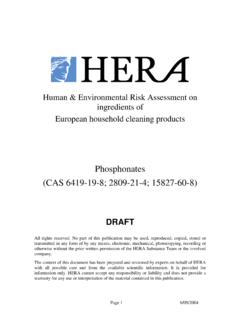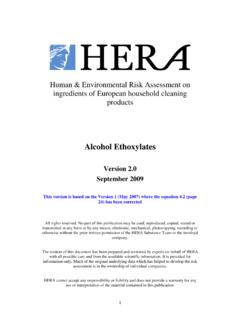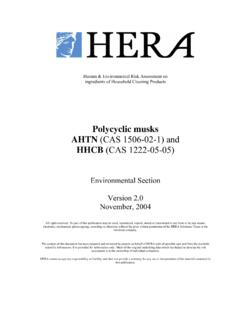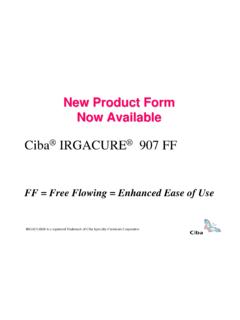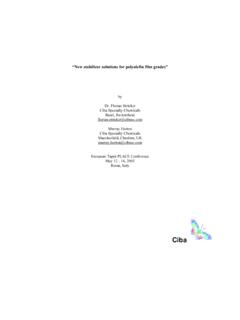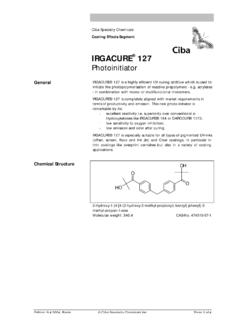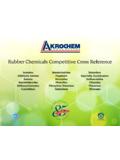Transcription of Human & Environmental Risk Assessment on …
1 Human & Environmental Risk Assessment on ingredients of european household cleaning products Substance: Fluorescent Brightener FWA-5. (CAS 27344-41-8). DRAFT. Version November, 2003. All rights reserved. No part of this publication may be used, reproduced, copied, stored or transmitted in any form of by any means, electronic, mechanical, photocopying, recording or otherwise without the prior written permission of the HERA Substance Team or the involved company. The content of this document has been prepared and reviewed by experts on behalf of HERA with all possible care and from the available scientific information. It is provided for information only. HERA cannot accept any responsibility or liability and does not provide a warranty for any use or interpretation of the material contained in this publication.
2 HERA targeted risk Assessment of FWA-5, May, 2003 DRAFT. 1. Contents PAGE. 1. Contents .. 2. 2. Executive Summary .. 3. 3. Substance 4. Chemical Structure and 4. Manufacturing Route .. 5. Use Applications 5. 4. Environmental Assessment .. 6. Environmental Exposure Assessment (EUSES ) 6. Substance Data Used for ERA .. 6. EUSES Scenario Description, PEC .. 7. Monitoring 7. PEC Calculations .. 11. Environmental Effects 12. Ecotoxicological Data Used for ERA .. 12. Data Evaluation for 12. Algae .. 13. Invertebrates .. 13. Fish .. 13. Terrestrial .. 13. Estrogenic 14. Derivation of PNEC .. 14. Environmental Risk 14. Risk Characterisation of EUSES Scenario Default and HERA .. 14. Risk Characterisation of the Monitoring Results.
3 15. EUSES Sensitivity Analysis to ERAs .. 16. Default Scenario EUSES versus HERA and 16. Variability of Usage Figures Over 17. Variability of FWA-5 Usage in Laundry Detergents of Selected european Countries .. 19. Variability of Photolysis within Europe Depending on Latitude .. 21. Conclusions .. 23. 5. Human Health Assessment .. 25. Consumer Exposures to FWA .. 25. Product Types .. 25. Consumer Contact Scenarios .. 25. Consumer Exposure Estimations .. 25. Hazard 28. Summary of Available Toxicological 28. Acute 29. 31. Repeated Dose Toxicity .. 33. Genetic 34. Carcinogenicity .. 37. Reproduction and Developmental Toxicity .. 38. Additional Data .. 40. Identification of Critical 44. Determination of 45. Risk 45.
4 Margin of Exposure (MOE) 45. Risk Characterization .. 46. Discussion and 47. 6. References .. 48. 7. Contributors to the 52. 2 of 52. HERA targeted risk Assessment of FWA-5, May, 2003 DRAFT. 2. Executive Summary FWA-5 is a Fluorescent Whitening Agent (FWA) mainly used in household detergents in concentrations ranging from 0,02 to 0,1%, and to a far lesser extent in textiles and paper. An extensive research program has been conducted by the Swiss Institute of Technology (ETH) and the chemical industry to characterise and assess the final fate and Environmental risks of FWA-5. It has been shown that DSBP-type FWAs undergo in aqueous system a rapid isomerization, followed by a photodegradation of >70% within 28 days.
5 The two defined yielding photodegradation products are readily biodegradable according to OECD 301F. Due to the comprehensive database it was possible to conduct Environmental Risk Assessments (ERA) with the default values of EUSES as well as with a HERA specific detergent scenario and to compare with monitoring values from 18 Swiss and German rivers. All results in the calculated/measured Environmental compartments (water, sediment, terrestrial, air) indicate PEC/PNEC ratios of well below 1. These findings were confirmed by the Dutch RIVM (Dutch National Environmental Protection Agency). The comparison of the EUSES defaults and HERA detergent scenario with monitoring data confirmed that the HERA detergent scenario is more conservative than monitoring but far closer to the measured values then EUSES default.
6 Exposure estimates from consumer product uses indicate the aggregate estimated FWA-5. internal exposure is g/day which is the Systemic Estimated Dose (SED) and accounts for all relevant dermal and oral exposures. Inhalation exposures are considered to be negligible. Considering the lifetime exposure of consumers to products containing FWA-5, the critical endpoint selected was from the lifetime feeding study in rats that indicated the relevant NOAEL is 190 mg/Kg/day. The estimated Human exposure to FWA-5 shows a Margin of Exposure of > 330'000. Risk characterisation indicates this is an adequate difference to cover all uncertainties in the toxicology database and extrapolations and supports a conclusion that FWA-5 is not of concern for use in consumer products.
7 From the available data it can be concluded that FWA-5 as applied to detergent uses is not expected to result in adverse effects to humans or the environment. 3 of 52. HERA targeted risk Assessment of FWA-5, May, 2003 DRAFT. 3. Substance Characterisation Chemical Structure and composition FWA-5 has the CAS chemical name Benzenesulfonic acid, 2,2'-([1,1'-biphenyl]-4,4'-diyldi- 2,1-ethenediyl)bis-, disodium salt with the chemical structure +. O Na O S O O S O. +. Na O. The purity of the active ingredient is >98,5%. The main by-product is Methylene-bis- benzenesulfonic acid, 2,-([1-biphenyl], the minor products identified consist of derivatives of benzenesulfonic acid, 2,-([1-biphenyl]. In literature, FWA-5 is often referred to DSBP.))
8 (Distyrylbiphenylsulfonate). Summary of Physico-chemical data Test Method Result Literature cited Reliability (Klimisch*). General name FWA-5 1[HEDSET]. Description Benzenesulfonic 1 [HEDSET]. acid, 2,2'-([1,1'- biphenyl]-4,4'- diyldi-2,1- ethenediyl)bis-, disodium salt CAS-No 27344-41-8 1[HEDSET]. EC-notification no. - EINECS no. 248-421-0 1[HEDSET]. Physical state yellow powder Density EEC 84/449/A 1490 kg/m3 6[CIBA-GEIGY] 1b Molecular weight g/mol 1[HEDSET]. Melting point OECD 102 >300 C 2[CIBA-GEIGY] 1b Boiling point n/a Vapour pressure OECD 104 <7E-16 Pa at 25 C 3[CIBA-GEIGY] 1b Octanol-water OECD 107 at pH and 4[CIBA-GEIGY] 1b partition coefficient 25 C. [log10]. Water solubility [mg/l] OECD 105 17'600 at 20 C 5[CIBA-GEIGY] 1b Fat solubility OECD 116 < mg/100g fat 7[CIBA-GEIGY] 1b at 37 C.
9 PH at 50 g/L;. 20 C. pKa (free acid) OECD 112 >pKa> 8[CIBA-GEIGY] 1b Stability in water OECD 111 T1/2 = > 1 year at 9[CIBA-GEIGY] 1b 4 of 52. HERA targeted risk Assessment of FWA-5, May, 2003 DRAFT. pH 4 to 9. Manufacturing route [Ullmann, 1991]. Accordin to Ullann's Enzyclopedia of Industrial Chemistry, the production of Distyryl- biphenylsulfonate FWAs starts with biphenyl, which is produced along with other aromatic compounds during the refining of crude oil. Reacting it with hydrogen chloride and formaldehyde produces the intermediate 4,4'-bis(chloromethyl)biphenyl, which reacts with trimethylphosphite to give 4,4'-bis(dimethoxyphosphonomethyl)biphen yl. This symmetrical biphenylphosphonate is reacted with two molecules of benzaldehyde-2-sulphonic acid, a compound which is produced from 2-chlor-benzaldehyde and sodium sulphite.
10 The content on active ingredient is approx. 90% another < consist of by-products and the balance is sodium chloride and water. Ciba Specialty Chemicals Inc. is the only producer of FWA-5 in Europe. The production volume is >1000 t/a therefore, FWA-5 was notified as HPV product. The european usage was approximately 600 tons in 1998; it varies from year to year according to the market trends. Use applications summary [Kramer, 1992]. FWA-5 is a Fluorescent Whitening Agent (FWA)based on Distyrylbiphenylsulfonate. FWA-5 has a higher yield of whiteness then the classical stilbene type brighteners. FWA-5. has also a high affinity to cellulosic fibres and is stable towards chlorine. More then 90% of this brightener is used in household detergents in concentrations ranging from 0,02 to 0,1%, and the balance in textiles and paper.




